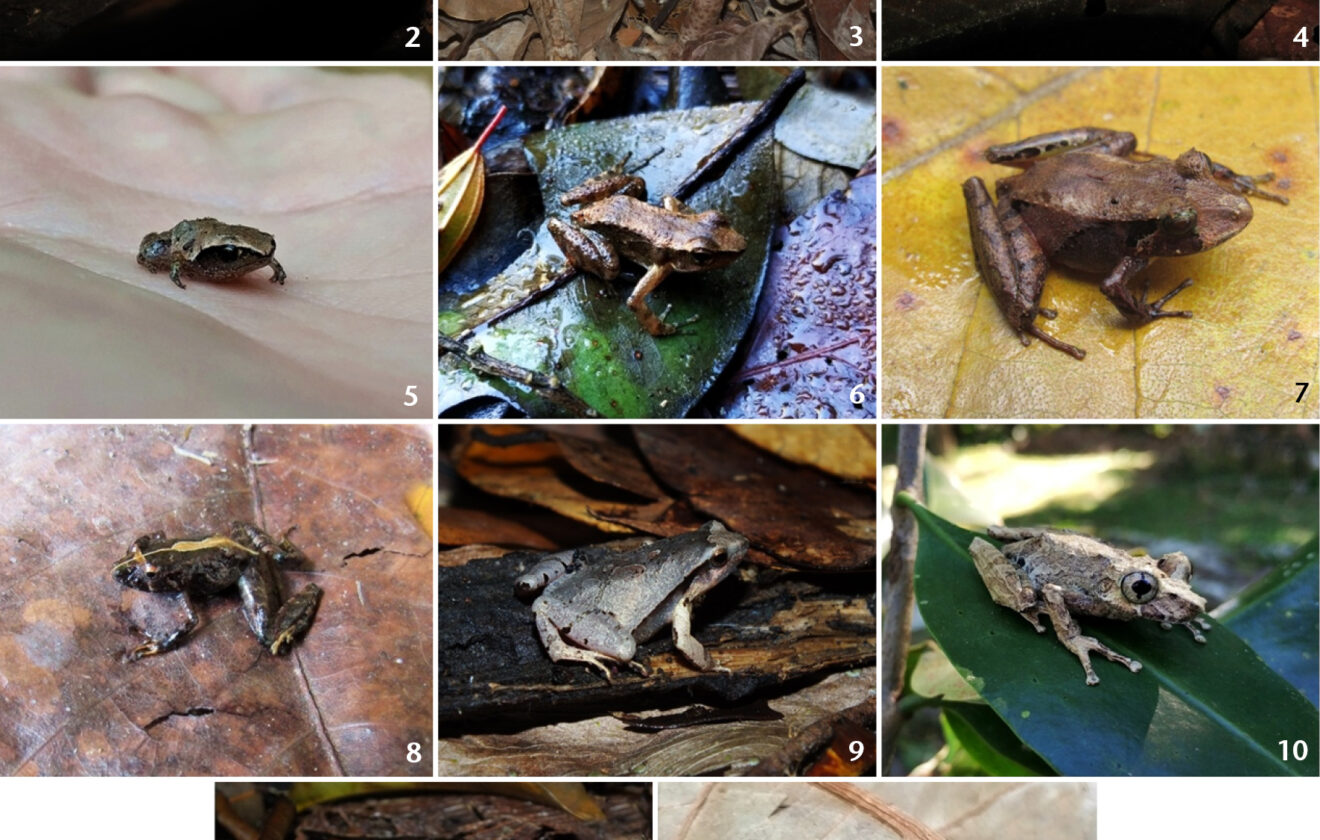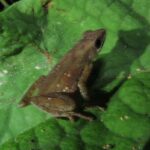- Hidden Wonders of the Forest Floor: Discovering Ischnocnema oea, the Secretive Brazilian Frog
- Understanding the Taxonomy of Ischnocnema oea
- The Mysteries of Home: Habitat of Ischnocnema oea
- Elegance in Miniature: Physical Characteristics of Ischnocnema oea
- A Peek Into the Secret Lives: Behavior and Lifecycle of Ischnocnema oea
- A Small Frog, a Vital Player: Ecological Significance
- Threatening Shadows: Conservation Challenges Facing Ischnocnema oea
- Cultural Impression and Future Discoveries
- Preserving a Unique Treasure: The Future of Ischnocnema oea
Hidden Wonders of the Forest Floor: Discovering Ischnocnema oea, the Secretive Brazilian Frog#
In the verdant depths beneath Brazil’s Atlantic Forest canopy, a chorus of hidden life thrives unseen. Amongst leaf litter, fallen branches, and tangled vegetation dwells a frog few have heard of and even fewer have glimpsed—the secretive, fascinating Ischnocnema oea. Small yet remarkable, this frog plays an understated but crucial role in the diverse rainforest ecosystem, quietly demonstrating its unique adaptations and behaviors.
Ischnocnema oea belongs to a special lineage of frogs that intrigue both biologists and nature enthusiasts. While many frogs lay eggs in water, relying on streams or ponds, Ischnocnema oea stands apart as a direct-developing species, skipping the aquatic tadpole stage entirely—a remarkable adaptation that adds to its allure.
This article delves deeply into the captivating world of the Ischnocnema oea, exploring its taxonomy, habitat, behavior, and ecological role. We’ll also discuss the conservation threats it faces and how understanding and protecting this elusive amphibian can help preserve the integrity of its vibrant rainforest home.
Understanding the Taxonomy of Ischnocnema oea#
To truly appreciate Ischnocnema oea, it’s vital to understand its place within the animal kingdom. Belonging to the diverse frog family Brachycephalidae, this small amphibian is part of a fascinating genus, Ischnocnema, that includes several direct-developing frog species. Its scientific name, Ischnocnema oea, reflects its unique biological and taxonomic identity.
First formally described by herpetologists, Ischnocnema oea epitomizes the evolutionary creativity that amphibians exhibit when adapting to distinct ecological niches. Its closest relatives, also within the genus Ischnocnema, similarly display the direct developmental pattern—an adaptation well-suited to their humid, terrestrial habitats in Neotropical forests. By bypassing the typical tadpole stage completely, this lineage of frogs avoids the vulnerabilities associated with aquatic life stages, allowing them to flourish exclusively on land.
The Mysteries of Home: Habitat of Ischnocnema oea#
Imagine a forest whose floor is perpetually damp, shaded by towering trees easily reaching over forty meters skyward. Leaf litter carpets the ground, providing not only nourishment but also shelter to a diverse community of insects, fungi, mammals, and amphibians. This describes precisely the preferred habitat of Ischnocnema oea: the lush Atlantic Forest biome, concentrated predominantly along Brazil’s eastern coastline.
A Deeply Specialized Existence#
Ischnocnema oea has adapted remarkably well to this environment, favoring areas of thick leaf litter, rotten wood, and shaded slopes covered in mosses and ferns. The constant humidity provides the ideal microclimatic conditions needed for their survival. They shun sunlight, thriving instead in shaded understories where moisture levels remain consistently high, ensuring their sensitive skin stays hydrated, facilitating proper respiration through their permeable epidermis.
The lush, decomposing forest floor offers ample concealment and an abundant food supply of small arthropods, including tiny insects, mites, ants, and spiders—prey items upon which Ischnocnema oea meticulously relies.
Elegance in Miniature: Physical Characteristics of Ischnocnema oea#
Captivatingly miniature, adults of Ischnocnema oea typically measure no longer than two centimeters from snout to vent. Their skin texture varies subtly from smooth to mildly granular, usually an adaptation to help blend seamlessly with surrounding leaf litter and tree bark. The frog’s coloration ranges from tan or brown shades to deepen mossy greens, frequently adorned by irregular patterns or blotches. These subtle markings not only provide excellent camouflage but also lend the species a notably elegant appearance, as though painted by nature’s brushstroke.
Adaptations for Survival#
Its diminutive stature serves multiple functions, from facilitating stealthy movement within dense vegetation to reducing vulnerability to large predators. Large eyes relative to their small frame allow these frogs exceptional night vision, essential for hunting and avoiding predators. Their limbs, slender yet muscular, grant them agility and precision—essential when navigating the labyrinthine terrain of their rainforest microhabitat.
A Peek Into the Secret Lives: Behavior and Lifecycle of Ischnocnema oea#
While many frogs attract attention with boisterous nighttime choruses, Ischnocnema oea is relatively quiet and elusive. Active predominantly during twilight and night hours, this small frog tends to hide under leaves and logs during daylight, conserving moisture and energy. As darkness blankets the forest, they cautiously emerge to feed, silently stalking tiny insects and arthropods through leaf litter.
An Unique Approach in Amphibian Reproduction#
Perhaps the most extraordinary aspect of Ischnocnema oea’s biology is its lifecycle—a complete departure from typical frog development. Instead of laying their eggs in water bodies, females lay relatively few, larger eggs tucked snugly into sheltered leaf litter or crevices in rotting logs. These eggs hatch directly into miniature froglets, bypassing the entirely aquatic larval stage. Not needing ponds or streams to reproduce has enabled this frog to exploit niches inaccessible to many amphibians, contributing to thriving localized populations within suitable microhabitats.
Slow and Steady Parenting in the Forest Understory#
Remarkably, these frogs show indirect parental investment by selecting optimal laying sites that ensure higher survival rates for developing eggs. By situating eggs in protected leaf litter areas, they cleverly avoid predation and environmental hazards commonly faced by aquatic tadpoles, thus ensuring higher offspring survival rates.
A Small Frog, a Vital Player: Ecological Significance#
Though diminutive, Ischnocnema oea plays a significant ecological role in the Atlantic Forest ecosystem. As insectivores, these frogs assist in controlling invertebrate populations, maintaining balance within their microhabitats. Through their selective predation, they influence vegetation health in the forest undergrowth indirectly, illustrating their significance as integral parts of the food web.
Moreover, Ischnocnema oea serves as prey for larger creatures, such as birds, larger frogs, and small mammals. Their presence reflects healthy forest conditions; thus, ecologists consider them reliable indicators of habitat quality and biodiversity.
Threatening Shadows: Conservation Challenges Facing Ischnocnema oea#
Despite living secretively tucked away within one of Earth’s biodiversity hotspots, Ischnocnema oea is vulnerable to several conservation threats. Rampant deforestation in Brazil’s Atlantic Forest has dramatically reduced suitable habitats, fragmenting their populations and threatening their long-term survival.
Additionally, climate change poses a mounting threat. Rising temperatures and prolonged droughts disrupt the moist microclimates upon which these frogs depend. Diseases like chytridiomycosis, though currently not documented in the species, remain concerns given their devastating impacts on amphibians globally.
Currently, Ischnocnema oea is classified by the IUCN as Data Deficient—a status reflecting both limited information and uncertainty regarding its conservation outlook. This underscores the urgent need for detailed field research and habitat protection.
Cultural Impression and Future Discoveries#
While Ischnocnema oea isn’t as culturally famous as poison dart frogs or cryptic treefrogs, the species still embodies the mystery and wonder of Brazilian biodiversity. It serves as an important emblem in educational campaigns focused on habitat conservation and amphibian ecology. For biologists studying evolution, the unique reproductive strategies of Ischnocnema oea offer valuable insights into amphibian survival and adaptation, making the species a meaningful subject for continued scientific research.
Preserving a Unique Treasure: The Future of Ischnocnema oea#
Though small and elusive, Ischnocnema oea enriches our world through its unique adaptations, behaviors, and pivotal ecological roles. Its quiet life in the hidden niches of Brazil’s Atlantic Forest reminds us profoundly of nature’s intricacy and fragility. As humans increasingly impact rainforests worldwide, understanding species like this frog becomes even more crucial. Protecting Ischnocnema oea means protectively embracing the delicate integrity and diversity of an entire ecosystem.
We invite you to learn more about rainforest conservation, support habitat preservation initiatives, and share this remarkable story. Together, we can ensure that small amphibians like Ischnocnema oea not only survive but thrive in their secret, leafy homes for generations to come.










